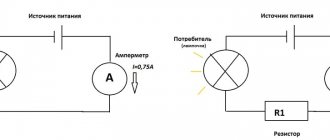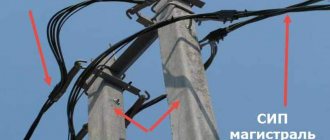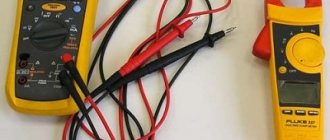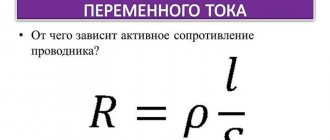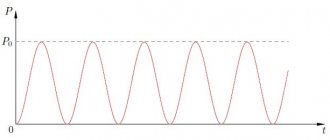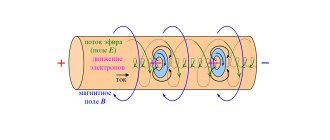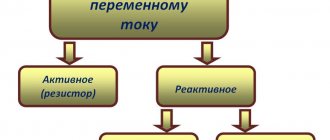Having connected the current source to the conducting circuit, using a multimeter, measure the potential difference (voltage) at the control points. It is easy to establish experimentally that electrical parameters change when using a resistor made of different materials. Similar results are obtained by experimenting with different cross sections. With the help of this article you can find out what the resistance of a conductor depends on. The knowledge gained will be useful for creating functional electrical circuits. They are needed for the correct repair and modernization of radio devices, ensuring personal safety during individual work operations.
During the experiment, it is easy to establish the dependence of the measured values on the parameters of the conductor
Concept of electrical resistance of a conductor
The classical definition explains electric current by the movement of “free” (valence) electrons. It is provided by the electric field created by the source. Movement in the metal is hampered not only by the normal components of the crystal lattice, but also by defective areas, impurities, and inhomogeneous areas. During collisions with obstacles, due to the transition of momentum into thermal energy, the temperature increases.
A good example is heating water with a boiler.
In gases, electrolytes and other materials the physics of the phenomenon is somewhat different. Linear relationships are observed in metals and other conductors. The basic relationships are expressed by the well-known formula of Ohm's law:
R (electrical resistance) = U (voltage) / I (current).
For convenience, the inverse quantity, conductivity (G = 1/R), is often used. It denotes the ability of a certain material to pass current with certain losses.
To simplify, the example of a water pipe is sometimes used. A moving fluid is an analogue of a current. Pressure is the equivalent of voltage. By decreasing (increasing) the cross section or position of the locking device, the conditions of movement are determined. In a similar way, the basic parameters of electrical circuits are changed using resistance (R).
For your information. The amount of liquid passing per unit time through the control section of the pipe is the equivalent of electrical power.
Ohm's law for a circuit section
Ohm's law for a circuit section : current is directly proportional to voltage and inversely proportional to resistance:
Comment. This law underlies the science called electrical engineering.
Since the voltage in the law is considered at the ends of the conductor and the resistance of the conductor itself is taken into account, the law is applicable specifically to a section of the circuit, that is, to any part of it.
Designations:
voltage, V;
current strength, A;
resistance, Ohm.
When working with Ohm's law, you should understand that it can be fulfilled separately for each section of the circuit under consideration with different values of the parameters included in it.
In the next lesson we will talk about what parameters the conductor resistance depends on.
Dependence on material properties
What does inductance depend on?
For standardization, the unit of measurement was 1 ohm. This resistance creates a column of mercury 1 square meter thick. mm, height – 1063 mm. Measurements are performed while maintaining zero temperature.
To simplify calculations, use the specific resistance value Rsp, which is created by conductors made of other materials (Length x Sectional area = 1,000 mm x 1 sq. mm).
Resistivity (conductivity)
The figure shows Rsp (silver) = 0.016. This means that a meter conductor with a normalized cross-sectional area of 1 mm sq. creates an electrical resistance of 0.016 ohms. Information about other materials can be taken from the reference book.
What needs to be clarified when affecting joint ventures
The title of the article is the starting point of the story about a whole group of concepts, each of which relates to SP. And that's why. The very concept of “resistance” means preventing something. Therefore, when a conductor is mentioned, it refers to the way it prevents electric current from passing through it. But, as you know, current can be alternating and direct. Therefore, let’s clarify right away:
- The joint conductor as a whole depends on the properties of the voltage acting on it, the material and spatial-geometric characteristics of the conductor at a certain ambient temperature, and the force applied to it.
From this general formulation the following concepts follow:
- active resistance,
- reactance,
- impedance,
- wave resistance.
The disclosure of the listed concepts gives a general idea of what the joint venture depends on.
Dependence on voltage properties
Resistivity
After a simple transformation of the basic formula, you can create the correct expression for voltage:
U = I * R.
The current source generates electricity. The connected resistor consumes energy and is converted into heat. To maintain a certain current strength, it is necessary to set the appropriate voltage.
Measuring circuit, graphs
The graphs show the current-voltage characteristics of different devices. The first two demonstrate linear dependencies in which only the angle of inclination of the straight line changes (depending on the electrical resistance of the resistor).
If you connect a semiconductor diode, the graph will change significantly. From the figure, one can determine the low resistance in the region of positive values of U. However, after a change in polarity, an increase in negative voltage is not accompanied by a similar change in current. One-way conduction is, in particular, used to rectify signals.
In the last graph, the shifted zero current transition point indicates the EMF of the power source. As in the previous example, a small angle relative to the vertical indicates a low internal resistance of the battery.
Geometry Dependency
Conductor inductance
From the section describing the specific parameters it is clear that the electrical resistance of the conductor depends on the length. If we take a silver sample (standardized cross-sectional area 1 sq. mm) with a length of 6.8 m, it is easy to calculate the value R = 6.8 * 0.016 = 0.1088 Ohm.
Other practical problems are solved in a similar way. To create a wire with an electrical resistance of 100 Ohms, you will need a silver wire 6,250 m long = 100/0.016. If we use a metal conductor made of iron, the length will be 833 m = 100/0.12.
The next decisive factor is the cross-sectional area. For clarity, you can use the example of pumping liquid from the main tank into two different containers. It is easy to create the necessary pressure by raising the main tank to a small height. By using tubes with different duct diameters, you can see the difference in the rate of filling of control volumes. If the readings are measured, if desired, it is easy to create proportional dependencies taking into account the initial geometric parameters of the transport channels.
The size of the conductors also matters. Electrical resistance (R) is equal to the specific value for a particular material (Rsp), multiplied by the length (L) and divided by the corresponding cross-section (S). If only the diameter is known, then for a round core you can apply the classic formula from a school geometry course:
S = (π * d2)/4 = (3.14 * d2)/4.
The length is calculated using the converted expression:
L = S * (R/ Rsp).
These proportions demonstrate what resistance depends on.
Calculation of conductor resistance
Simplified methods that need to be adjusted taking into account real conditions were discussed above. Thus, temperature has a significant effect on the conductivity of materials. In serial conductors (copper, aluminum), the value of this parameter increases in the proportion of 0.3-0.5% for each degree. In carbon-based compositions and electrolytes, the opposite effect is observed - a decrease in resistance.
Without holding strings or other devices for tricks, real levitation using superconductivity is provided
The experiment shown in the figure can be reproduced by lowering the temperature of the metal to “absolute zero” (-273°C). With such extreme cooling, the atomic lattice is fixed in a stable position.
This state creates ideal conditions for the movement of electrons. The absence of obstacles is accompanied by minimal losses, which explains the promising direction for creating efficient energy transmission lines. The example in the figure demonstrates improved operational parameters of transport communications. In this case, friction forces can be eliminated.
Combination of airless tube and superconductivity improves performance of advanced transport systems
It is clear that to improve economic performance it is necessary to increase the operating temperature while maintaining good conductivity. However, the latest scientific achievements in the relevant field allow us to count on positive results in the near future.
It should be emphasized! In practice, different computing technologies may be needed. For example, the material is unknown. It is difficult to identify it by external signs. For high-quality chemical laboratory analysis, in addition to the appropriate skills, special equipment is required.
However, if necessary, it is easy to derive the specific indicator:
Rsp = R * S / L.
Geometric parameters are measured with standard tools (ruler, caliper). According to a typical measurement scheme, electrical resistance is determined using a multimeter. To calculate Rsp, use the formula presented above. In the directory, select the position corresponding to the calculation result. Using the same technique, you can determine other unknown values, for example, the length of the cable in an underground route.
In actual calculations, the reactive components of the conductors are taken into account to improve accuracy. For example, the inductance of a long straight line is determined by the formula:
AND = (m0/2π) * L *(mc * ln(L/r) +1/4m,
Where:
- m – magnetic permeability of the material (o – constant, c – environment);
- r and L are the radius and length of the conductor, respectively.
As the frequency increases, it is necessary to take into account current spreading in the surface zone and vortex changes.
The theoretical knowledge presented will be useful for calculating and creating a rheostat - a device with adjustable resistance. They are needed to prevent electrical injuries using precise calculations of protective circuits and specialized circuit breakers (fuses).
Theory and practice
So, if a person is even a little familiar with the basics of electrical engineering, he should know that the thicker the wire, the lower the resistance.
- Theoretically, this can be compared to a water pipe through which water flows. If the diameter of the pipe is sufficient, then the liquid flows through it without experiencing any hydraulic resistance, and vice versa, a small hole increases the pressure in the pipe, the throughput drops, and the hydraulic resistance increases.
- Also, the flow of electrons can be represented as water trying to flow inside the wire. However, electricity is a completely different nature, and accordingly its physical properties are different.
- What can cause too high resistance? The most common thing is a voltage drop, as a result of which some incandescent lamp will burn dimmer, and some electrical appliance will not be able to start.
- A direct consequence of the passage of a powerful current through a conductor with a sufficiently high resistance will be its overheating.
From the author! One day we connected the welding machine to, well, a very bad extension cord, and after a few minutes of work the wire literally caught fire. Fortunately, a short circuit did not occur, but it was very likely. As is clear, such situations are unacceptable in a residential area.
We recommend proceeding in the following sequence:
- First of all, find out exactly how much load both of your devices create when operating at maximum power. We are interested in current strength, measured in Amperes, or power - Watts.
- You can easily find these parameters in the product data sheets.
- If both devices are powered from the same line, then sum the resulting values.
- Next, use the table, which will allow you to accurately determine the wire cross-section.
The photo shows a table for selecting conductor cross-sections
- As can be seen from the table above, the maximum current for a copper wire with an area of 0.5 should not exceed 11 Amperes.
Advice! Today the use of aluminum wires is not allowed in residential premises. Only copper ones are used.
- In principle, one could limit ourselves to these data, adding some margin, but such tables do not show what the maximum resistance of the wire should be, that is, the length of the conductor is not taken into account. Therefore, for greater accuracy, calculations are indispensable.
Video
Coffee capsule Nescafe Dolce Gusto Cappuccino, 3 packs of 16 capsules
1305 ₽ More details
Coffee capsules Nescafe Dolce Gusto Cappuccino, 8 servings (16 capsules)
435 ₽ More details
Powerline adapters

